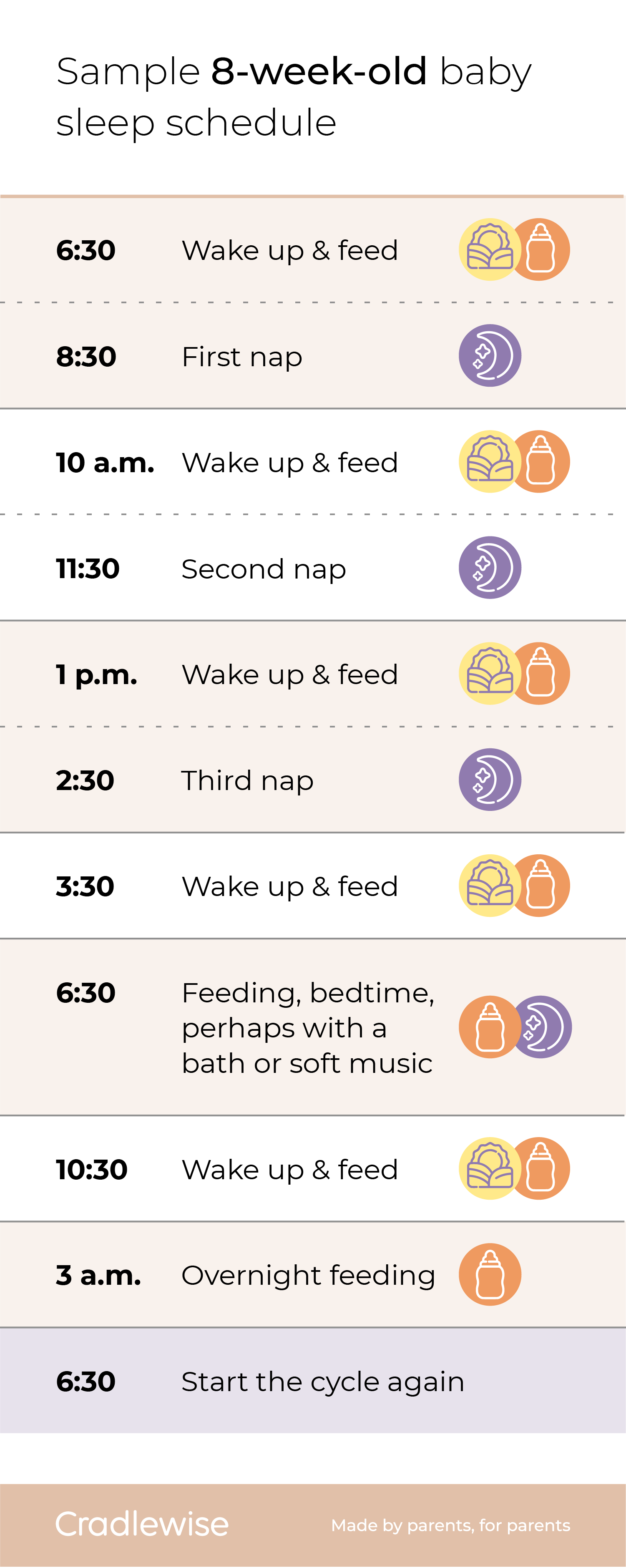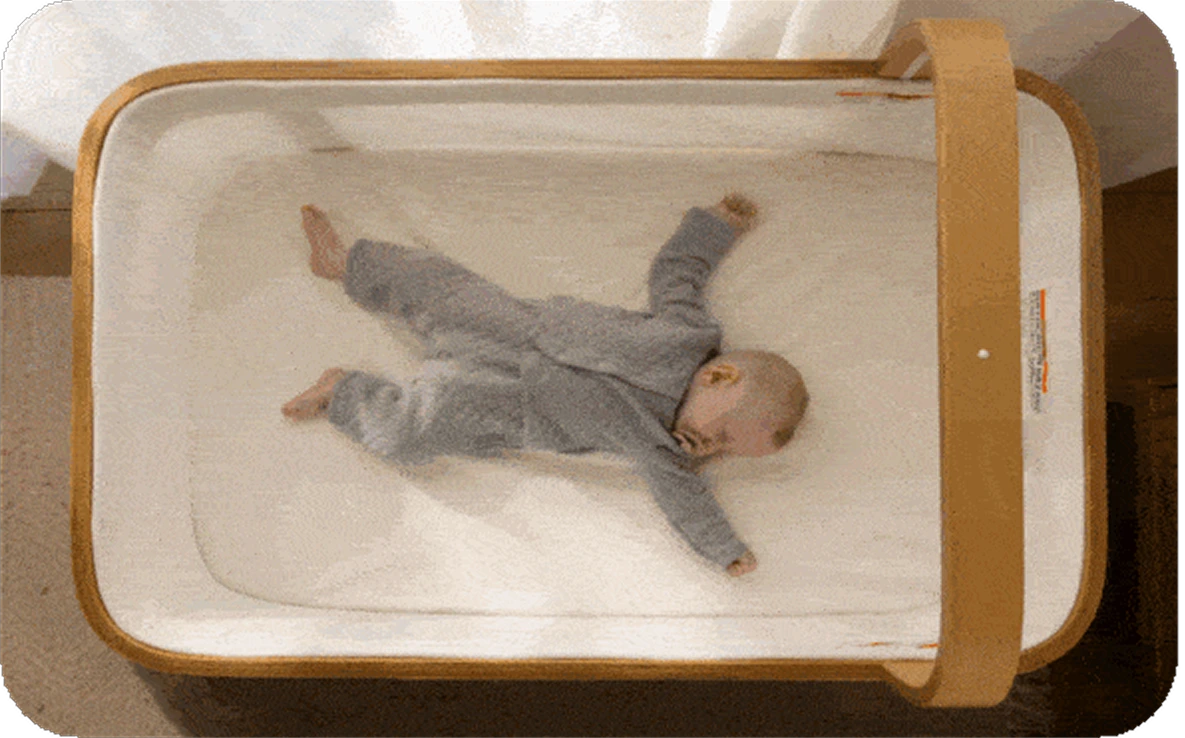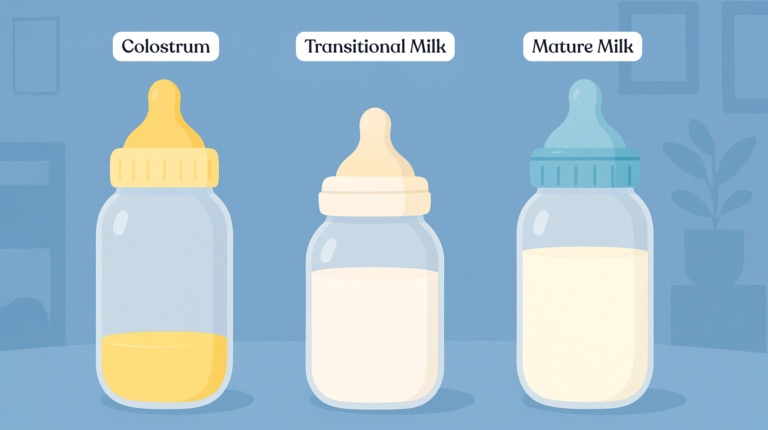
Night sleep
8-10.5 hours

Daytime naps
6-7.5 hours

Total sleep
14-17 hours
You’ve been a parent for one full month! We’re guessing you’re probably feeling a bit more comfortable and confident with the daily routines of life with a new baby, especially as you get a feel for their burgeoning personality. 🙌
That said, the newborn schedule, which still revolves around eating and snoozing, may still feel quite demanding, and month two is when your baby will likely be reaching their peak period of fussiness, if they have one (not all do!).
But you’ve also got some exciting things to look forward to this month: Evening crankiness should start to subside during the second half of the month, nighttime sleep stretches may get longer and you can look forward to the wondrous milestone that is your baby’s first social smile. Read on for research-backed information and suggestions about how to help your 8-week-old baby sleep comfortably—which means better rest for you, too.
Two-month-old baby milestones for sleep
It’s time to get ready for 8-week-old baby milestones! During month two, you can start to see the beginnings of the person your baby will become, as they return your smiles, usually around six weeks, and some may even start to coo and gurgle (gotta love the way an 8-week-old baby “speaks!”). Some parents even notice their 8-week-old laughing in sleep, which at this age is likely a harmless reflex response. This also means infants will show more interest in their environment, which is a natural part of their development, but may mean they fight sleep a bit.
Tummy time for your 2-month-old is also going to be an incredibly important to ensure they’re meeting their physical milestones. It will help strengthen their neck and chest muscles, and prepare them for all the crawling. You can start from birth and aim for two or three times each day for about three to five minutes at a time, working up to longer sessions as your baby gets stronger. To help cut down on frustration, try it after a nap or first thing in the morning, when your baby is well-rested.

💥 BLACK FRIDAY SALE 💥
Smarter Sleep for Your Baby
An award-winning crib—loved by parents, approved by experts.
0 to 24 months of use
Automatic soothing
Built-in video & sound machine
AI-powered sleep insights
Customizable soundtracks
Get 2 extra hours of sleep nightly
Although circadian rhythms still aren’t fully established, you will start to notice that your baby is showing signs of drowsiness earlier in the evening, thanks to the beginnings of melatonin production. As their stomach capacity increases, they may be ready to drop an overnight feeding, but some babies will still require it, and you should continue to feed on demand.
A key thing to remember is that for most babies, fussiness will be at its worst around six-weeks. Their nervous system lacks inhibitory control, and you may see not only crying (which can feel endless!), but also quivering and shaking. The good news is that after six weeks, the fussiness will decrease and they may start sleeping longer stretches. For a small percentage of babies, it may take longer—up to three or even four months—for their fussiness to disappear.
What’s going on in your baby’s brain?

Your baby’s nervous system is maturing, which means that some of the newborn reflexes will start to disappear both this month and next month, and your baby’s movements will start to become more purposeful.
As the gastrocolic reflex fades, your baby won’t be pooping after every feeding—for infants who breastfeed, it’s perfectly normal for them to only have a bowel movement every several days, while formula-fed babies might poop more frequently. (Bonus: You may not need to change as many poopy diapers during the wee hours.) Is your 2-month-old-baby constipated? You can try home remedies such as “bicycling” their legs, a gentle tummy massage or a warm bath, but talk to your pediatrician before making any changes to their diet.
By the end of this month, your baby’s eyes will also start to work together, so they’ll be able to track objects moving to and from them, which leads to depth perception. If you’re curious how far a 2-month-old can see, by six weeks of age they’ll be able to see about 12 inches in front of them, By six weeks of age, your 2-month-old can see as far as 18 inches away, and—fun fact!—by eight weeks, it will be easier for them to focus on their parents’ faces. You may find that your little one will be easier to distract or amuse, with fewer signs of frustration, but also more excited to be awake and check out what’s going on in the world.

Crib Notes
Are you dealing with an overwhelmingly fussy baby? It might be helpful to use the app’s “caregiver team” functionality, which allows loved ones to also check in on your baby. They can’t make your baby less cranky, but sharing the experience and hearing their words of love and support can go a long way.
How much should an 8-week-old baby sleep?

As with month one, you should continue following your baby’s cues, but you’ll also start to see some patterns emerging, which can feel like a relief. There will also be times when you might feel that as soon as you’ve gotten a handle on things, they change—this is a good metaphor for parenthood, too. 😝
- Total hours of sleep: You can expect your baby to be asleep for 14 to 17 hours within each 24-period. But as the second month progresses, you may notice that they’re sleeping a longer stretch in the evening, possibly as much as four to six hours, and this period generally begins before midnight.
- Wake windows: This month you may find your baby gaining stamina and being able to stay awake longer; that’s because the 2-month-old wake window is a bit longer than it was for your 1-month-old. But it’s still smart to watch their cues and aim to have each period of “awake time” be shorter than two hours, and many babies will be ready for sleep much sooner. As with the first month, try to soothe your child before they show signs of becoming overtired, and put them down into their Cradlewise when they’re drowsy but awake, so they can also practice their own self-soothing skills.
- Number of naps: Your 8-week-old baby might sleep a total of 6 to 7.5 hours each day, usually split into four to five naps. But as the month progresses, you will see your baby start shifting to sleep more hours overnight, and fewer during the day until they drop to one nap.
Sample 8-week-old baby sleep schedule
Keep in mind that this is just an example, since all babies are different. Yours might need an additional nap during the day, an earlier bedtime or an extra overnight feeding. And babies who breastfeed may eat more frequently than those who are bottle-fed.


Newborn feeding tips
During this time you’ll likely see your pediatrician around week five or six, and then again when your baby turns two months old. At this age, your baby should be gaining between ½ and 1 ounces each day, and your doctor will help you track the progress. The average weight for a 2-month-old is 11 pounds 5 ounces for girls, and 12 pounds 4 ounces for boys. If your child’s weight has leveled off, they will help you figure out how to make adjustments, which might mean taking steps to increase your milk supply, if you’re nursing, or increasing the amount of formula given at each feed.
- How much should a 2-month-old eat: Pediatricians often get asked how much a 2-month-old baby eats. At this age, it’s usually 4 to 5 ounces per feeding every three to four hours. Wondering how many wet diapers a 2-month-old should make? After the first week of life, you should expect to see at least six each day, with pale yellow urine (a darker color could indicate dehydration). And of course, if you notice your 2-month-old eating less than usual, or you have any concerns about feeding, that would warrant a call to your pediatrician.
Your baby’s stomach capacity is increasing, which may mean that they may be able to go longer stretches between feedings. That said, remember that most babies have a growth spurt around six weeks, so expect lots of hunger and fussiness around this period. You might notice the 8-week-old growth spurt, although 6 weeks and three months tend to be more common. During a growth spurt, your little one might seem inconsolable and may also have changes in sleep patterns: For example, if they had previously dropped an overnight feeding, you may see them needing it again. - How often should a 2-month-old eat: Babies at this age need to eat anywhere from every two to four hours. You can continue to log your baby’s feedings to help you estimate when they might sleep, which can help you plan your day. This can also be useful feedback to bring to your baby’s well visit appointments. Always ask your pediatrician for guidance if your baby was born prematurely, as they might have different feeding requirements.
- Tip: Burping is still a helpful tool to help your baby feel more comfortable. Breastfeeding parents should aim to try and burp their baby each time they switch breasts, and those who are bottle feeding can try after a few ounces, or when their baby takes a break from eating.
- Can my 2-month-old be teething?: You might notice your 2-month-old drooling. Teething generally starts closer to three months, but drooling in babies is generally totally normal. The American Academy of Pediatrics does indicate certain cases where drooling accompanied by additional systems, such as fever, mouth ulcerations or gasping for air would warrant a call to either your pediatrician or 911.

Crib Notes
Overnight, you may hear your baby waking and fussing. Rather than rushing in to feed your baby, you can wait a few minutes to see if the crib’s predictive soothing mechanism will help them get back to sleep.
How to help support your baby’s sleep during the second month

As with month one, you can still be guided by your baby’s cues, and take comfort in knowing that over the next few months, your baby will start developing more of a regular schedule.
Embrace the bedtime routine.
You may have started a before-sleep ritual last month, but if you haven’t, now is an ideal time to get one going. You might try singing lullabies, a bath, a massage, a book, or a combination of these suggestions. Keep it simple and consistent so other people, like relatives and babysitters, will be able to repeat it successfully when you’re not around.
Continue to use sleep aids.
At this age, continue setting the crib at a ‘High’ or ‘Very high’ level, so if your baby wakes up, it will automatically start the soothing process. (You can modify the crib ‘Sensitivity’ level on the connected app at any time to customize it for your LO’s growing needs.) If your baby still loves being swaddled or listening to the music or the white, pink or brown noise that Cradlewise can provide, there’s no reason to stop using these tools just yet.
Try an earlier bedtime.
You might notice that your baby is crying more in the evenings. During the second month, some babies are ready to shift to an earlier bedtime. So if your little one had been going to sleep for the evening between, say, 9 p.m. and 11 p.m., you might try to gradually put them down earlier, perhaps between 6 p.m. and 8 p.m.. An earlier bedtime might prevent your baby from getting overstimulated during the evening and having trouble getting to bed.
Favor crib naps.
During the first month, your baby might have snoozed through supermarket trips and walks in the park. But as your baby matures and starts to interact more with the world around them, they’ll have a harder time blocking out distractions. When possible, avoid naps on the go and let your little one nap in their Cradlewise, to reinforce the idea that the crib is THE place for sleeping.
Think big picture.
You might find that sleep can become interrupted when your baby has a growth spurt or is close to reaching a developmental milestone. Suddenly, your sweetie who had been sleeping for five hours straight overnight is waking up after three. These periods, known as sleep regressions, are completely normal, so try to remind yourself that they will pass. Continue to respond to your baby’s needs and make sure you’re getting enough rest as well, even if this means taking your own daytime naps.
Sources:
- Newborn crying peaks at six weeks. 2016. Zero to Three. Birth to three months: Your baby’s development
- Baby’s first social smile. 2021. HealthyChildren.org. When do babies first smile?
- Amount of sleep for newborns. The Sleep Foundation. How much sleep do kids need?
- Babies laughing during sleep. 2011. Nature Science & Sleep Journal. Sleep physiology and sleep disorders in childhood.
- Tummy time for babies. 2017. HealthyChildren.org. Back to Sleep, Tummy to Play.
- Newborns lack circadian rhythms at birth. 2017. Nature of Science and Sleep. Infant sleep and its relation with cognition and growth: a narrative review
- How far can a 2-month-old see. Nationwide Children’s. Infant Vision: Birth to One Year.
- Babies can see parents’ faces more easily. American Optometric Association. Infant Vision: Birth to 24 Months of Age.
- Fussiness peaks around six weeks. 2021. Healthy Sleep Habits, Happy Child, Fifth Edition.
- Newborn reflexes begin to fade during the second and third month. 2019. American Academy of Pediatrics: Caring for Your Baby and Young Child from Birth to Age Five, Seventh Edition.
- Changes in baby’s brain. 2019. American Academy of Pediatrics: Caring for Your Baby and Young Child from Birth to Age Five, Seventh Edition.
- Baby weight gain per-day ranges. 2019. American Academy of Pediatrics: Caring for Your Baby and Young Child from Birth to Age Five, Seventh Edition.
- Average weight for a 2-month-old. Centers for Disease Control & Prevention. Data table for gIrls length-for-age and weight-for-age charts and data table for boys length-for-age and weight-for-age charts.
- Baby feeding frequency. 2022. HealthyChildren.org. How often and how much should your baby eat?
- Drooling in 2-month-olds. HealthyChildren.org. 2016. Drooling and your baby.
- Newborns and feeding patterns. 2022. Mayo Clinic. Should I wake my newborn for feedings?
- Your baby may be ready for an earlier bedtime. 2019. American Academy of Pediatrics: Caring for Your Baby and Young Child from Birth to Age Five, Seventh Edition.
- Favor crib naps to avoid distractions. 2021. Healthy Sleep Habits, Happy Child, Fifth Edition.



